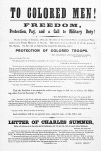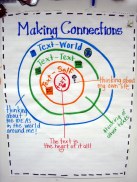Our teacher ranger , Rob Finkill, is back again for the summer at the Park, after a busy school year with his 8th grade students. . This summer’s blog series will tie into the National Park Service’s theme of Civil War to Civil Rights a theme that focuses on the experience of Americans journeying from slavery , freedom , and equal protection under the law. Our first post will focus on the Emancipation Proclamation and the experience of African Americans who will join into the service of their country and the success and challenges that were a part of their story.
A Call to the Citizens of Pennsylvania!
When word spread through Pennsylvania in the early summer of 1863 that a “large rebel force” was heading north, Governor of the Commonwealth, Andrew Curtin, issued a call for volunteers to report to Harrisburg to defend the state. The proclamation from the governor said nothing about the color of the volunteer’s skin.
Meanwhile, the city of Philadelphia was abuzz with the news and groups of volunteer soldiers were forming to respond to Curtin’s call for troops. The African American community was not deaf to the call for volunteers. At the Institute for Colored Youth on Lombard Street, a company of African American soldiers was being organized. On June 17, led by a young teacher named Octavius Catto, a group of around 100 African American volunteers headed to Independence Square to join the crowd of emergency recruits. With no questions asked, the company was given a commander (white of course), rifles, and uniforms and sent to Harrisburg by train. Here is where reality hit these men. Major General Darius Crouch, commander of the troops forming in Harrisburg, refused to take them into his army. He claimed he was only authorized to accept men who signed up for three years, whereas their emergency regiment was only signed up for a few months. The volunteers were outraged – Couch’s rejecting of able bodied men at a time of crisis on a technicality, was almost certainly done because of the color of their skin. But the men from Philadelphia would not be deterred. Upon returning to their city , a group of the soldiers went to the mayor and told him what had happened. The Mayor assured them an application to create a 3 year regiment had been sent to Washington, D.C. and by June 20, 1863 , orders arrived giving permission for a regiment to be formed in Philadelphia. On June 24, in a ceremony filled with speeches and patriotism, the African American men from Catto’s company would be the first troops placed in the United States army from Philadelphia. Soon their numbers would grow to form several regiments as a part of the United States Colored Troops. *
Actions Speak Louder than Words
By the summer of 1863, the United States, on paper was accepting the services of African American men into the army, but as these men found out , there is often a difference between what is on paper – in this case a proclamation – and what was going on in reality. Actions spoke louder than words in this case and that phrase could certainly be used as a unit or lesson theme about the experience of African Americans during the Civil War. Adapting your Civil War unit to different themes or “big idea” can help. Covering all the many aspects of the Civil War can be a challenging task. As I have discussed in previous posts, many teachers face a time crunch when teaching a Civil War Unit. (see a previous posts for a suggestion on how to maximize your time) The African American contribution to the war is an important one, and these lesson ideas will hopefully provide you with ideas on how to incorporate the experiences of the United States Colored Troops in your lessons.
In this post we will try to provide activities and resources that will:
- focus on the central idea (theme) that actions speak louder than words;
- allow student to understand the provisions of the Emancipation Proclamation;
- show how to tie the teaching of the Emancipation Proclamation and the experience of the United States Colored Troops together.
A problem to solve
When discussing the Emancipation Proclamation with students, it’s important to spend a few moments providing its context. As the war opened in 1861, the war was to be fought to keep the Union together and President Lincoln had stated he had no intention of disturbing slavery where it already existed. It was a limited war, with limited goals. The situation changed quickly as slaves and other abolitionist military officers took it upon themselves to either free themselves by running away to Union lines or by issuing orders that freed slaves in territories controlled by Union forces (which Lincoln quickly cancelled out). Visit the Fort Monroe National Monument page for a quick overview on these issues and the “contraband of war” including what General Benjamin Butler did when a slave owner came to his office demanding the return of his “property”. President Lincoln knew he would need a Constitutional amendment to end slavery completely, but what if slaves were looked at as captured property such as a horse or a wagon? The Union certainly wasn’t returning captured horses and wagons – those are the “spoils of war”. Slaves were viewed as property under the law and their “capture” could only serve to help the Union war effort as many slaves were being used to support the Confederate war efforts. Any slave who was returned to a master could be helping the Confederate cause and that helped Lincoln to be able to justify his actions regarding slaves in the Emancipation Proclamation, but not all slaves were freed. In the border states of Maryland, Kentucky, West Virginia , and Delaware, slavery would continue. In this case Lincoln used the law that said slaves were property to help form is rationale for the Emancipation Proclamation.
What it says on paper: the Emancipation Proclamation
Sometimes with a class of students with diverse reading abilities , it is easy to shy away from having students work with primary source documents such as the Emancipation Proclamation. There are many resources to help a teacher reach students at their level. This activity will pull from several free resources available online.
Here is a basic plan:
- Ask students to think of examples of times when “Actions Speak Louder Than Words” in their lives . Give them time to think and then discuss some as a class.
- Describe how we are going to see how words produced by the government don’t really mean anything until we as citizens put them into action or take actions based on the provisions in those statements.
- Go over a basic definitions of the terms “emancipation” and “proclamation
- At this point , provide the students with a copy of the Proclamation or key portions of text.
- The Civil War Trust provides an excellent series of documents and lesson ideas for an understanding of the Emancipation Proclamation . Page 4 in the document linked to below gives a very useful breakdown of key portions of text from the Proclamation complete with definitions of terms.
- Gettysburg National Military Park Education Page also has materials designed to help with understanding of the Emancipation Proclamation. Page 34, 35, 36 of the Unfinished Work Program Guide provide focusing questions and the text of the document.
The Unfinished Work Program guide from GNMP
Civil War Trust Emancipation Proclamation Activity (middle school level)
- Use this graphic organizer to help students break down the Emancipation Proclamation and the key provisions of it. Make sure students indicate the portion of text that supports their findings.
- After determining what the Emancipation Proclamation stated, have student explore what it looked like when the African American men and women served their country. Use this organizer to help student take notes on challenges and and successes of African Americans during the war.
Here are several different resources to pull information from:![]()
This reading describes reactions to the United States colored troops in battle and describes the bravery and accomplishments of several of the soldiers who fought in this battle
Teaching With Documents: The Fight for Equal Rights: Black Soldiers in the Civil War
from the National Archives
This site contains a series of activities and primary source documents to use in the classroom . This activity has a letter written by a Southern officer and a Northern officer describing when an African American soldier was captured by the Southerners. I have included a transcription of the cursive text.
Transcription of letters
Biography of Christian Fleetwood from civilwar.org
Medal of Honor Winner from the Battle of New Market Heights
Video : Black Soldiers in the Civil War from the Civil War Trust 4 minute video on the United States Colored Troops
Harriet Tubman during the Civil War Tubman was more than a conductor on the Underground Railroad
As always adapt this activities to your classroom situation – the Civil War Trust and Gettysburg National Park have the same activities for elementary and high school classrooms. Also , think about what type of closure or follow up activity could be done from these lessons. Share ideas and comments here.
Student Educational Programs are offered here at Gettysburg National Park in the spring and fall. The Unfinished Work program ties in with the Emancipation Proclamation and the Gettysburg Address!
Resources for Lesson:
Graphic organizers:
Emancipation Proclamation Student graphic organizer
Emancipation Proclamation Teacher graphic organizer
Note Taking chart on successes and challenges of African Americans in the Civil War
The Unfinished Work Program guide from GNMP
Civil War Trust Emancipation Proclamation Activity
Bibliography
“Battle of New Market Heights: USCT Soldiers Proved Their Heroism.”
Civilwar.org. Civil War Trust. Web. 15 June 2015.
“Fort Monroe and the Contraband of War.” NPS.gov. Fort Monroe National
Monument.
Paradis, James M. Strike the Blow for Freedom: The 6th United States
Colored Infantry in the Civil War. Shippensburg, PA: White Mane, 1998.
Next in our series we’ll take a look at the Reconstruction Amendments….


